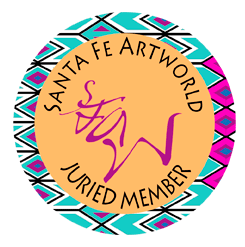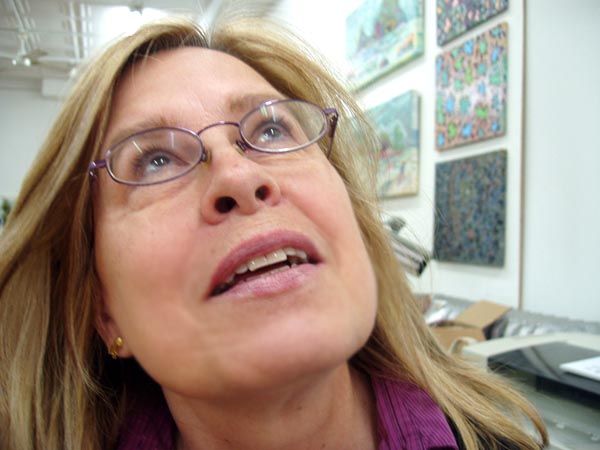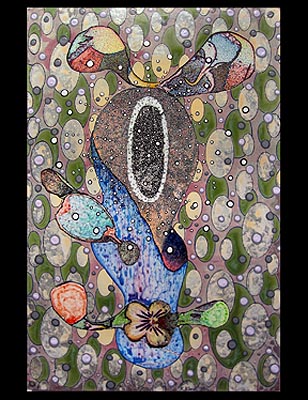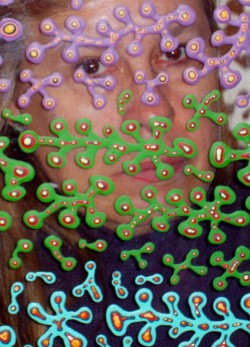Kathleen
King
Brief biography and interview


Kathleen King with
her work at her solo show at Viridian Gallery in Chelsea, NYC
Click on image to see a short video
interview with Ms. King
Upcoming Exhibitions
Kathleen King's "Divas,"
(June 8 - 26, 2010)
Viridian Artists Inc., 530 W. 25th St., room 407, NYC 10001.
For show details go to:
http://www.viridianartists.com/new/index.cfm/method/main.index/Viridian_Artists_Home

High Note Diva (36 x 24, 1.5 in., acrylic and mixed media on canvas,
2010)
Additional artwork on view
at Artslant: http://www.artslant.com/ny/user/login
Book Release of Living Artists which includes work by Kathleen King
New Project: Deciduous Divas, a wall mural at Oriole Park Branch Library
Quick Time Virtual Tour of King's show "Plastic Pictorials"

Click image to link to "Your
Gallery"
for more imagery by Kathleen King
Kathleen King is an artist living in Chicago and working in a variety of media, including painting, drawing, collage and monotype (unique prints). She has been exhibited nationally and internationally. Her representative is the Fine Arts Building Gallery in Chicago, Viridian Gallery in New York City Gallery, and Ami in Seoul, Korea. Ms. King has taught as an Adjunct Assistant Professor at the School of the Art Institute of Chicago and is currently an Adjunct Professor at Loyola University, Chicago.
Kathleen King has, in the past, worked from a floral-landscape genre, reminiscent of painter, Joseph Raffael and the monotypes of Michael Mazur. As of late, she has progressively moved from that tradition to a more surreal context. She has included influences from painter, Paul Klee and the digital artist Elaine Fisher in this most recent series of works. At the Fine Arts Building Gallery, Ms. King chats about her work:
Q. What inspires you?
A. Botanical fragments inspire me. They are dynamic forms that appear in endless varieties. Combined with photographic elements, as well as drawn and painted passages, these floral castoffs can represent a range of evocative images.
Q. What artists are you influenced by?
A. The current work of Sigmar Polka, a multimedia artist who produces brilliant works of a sociopolitical nature. The late, inventive Romare Bearden, a painter and collage artist, whose subjects are about Black cultural life. The surrealists, Paul Klee and Joseph Cornell--the latter's boxes . . . Also, I have a collection of African Kuba cloths which seems to defy regularity. These are some key influences.
Q. What is your work about, now?
A. It's about taking the bits and pieces directly from life and reassembling them to make poetic or metaphorical statements about the experience of being alive. I'd better do this now. I won't have time later. In the compositions, the critical mass of visual relationships occur in such a way as to allow the viewer to revisit the works and see the art in diffrent ways each time. I am interested in exploring the life of the mind, the poetic, musical, and picturesque as opposed to just the socio-political. The tone of this work is fanciful, sometimes quite baroque and romantic mixed with dark undercurrents.
Q. How do you want people to see your work?
A. Well, I don't want them to 'read' the work to solve a puzzle or to 'get it' and not care beyond that point. I want to keep the viewer engaged with the many, many visual relationships that I pack into the pictorial format that will sustain the viewer and keep him or her involved with the artwork. I hope the work will have a resonant presence that will 'sing to,' instead of 'talk at,' the viewer.
Q. Why do you consider your work multimedia?
A. I am not a pure painter. Each way a mark or surface is produced conveys an expressive component that I may be able to use if I don't take a limited approach to media. I am working in a 'collage mode' and I have been trained in printmaking. I'm a hybrid.
Q. You employ the computer in your work too, why?
A. I like to think of the computer as a toy. I use it in a very primitive way, because I am new to it. I tend to capture images, and surfaces on it, instead of digitally spending time refining images. The computerized elements in the work are incorporated with the more traditional media. I like the idea of twisting and subverting the computer media in my work so it does not have the starring role. These computers are great for arranging and composing, but in the final presentation, in my work, the other media has to take precedence.
Q. So the computer functions as a tool for collage?
A.
Yes. Infusing images of dreams and fantasy with a feeling of tangibility has always
been of interest to me. I have been increasingly employing a collage approach
in gathering and assembling these elements in my compositions. To get a better
idea of what my work is about read Octavio Paz's poem, Objects and Apparitions
-- for Joseph Cornell:*
Objects
and Apparitions -- for Joseph Cornell
by Octavio Paz
Hexagons
of wood and glass,
scarcely
bigger than a shoe box,
with room in them for night and all it's lights.
Monuments
to every moment,
refuse
of every moment, used:
cages for infinity.
Marbles,
buttons, thimbles, dice,
pins, stamps, and glass beads:
tales of time.
Memory
weaves, unweaves the echoes:
in the four corners of the box
shadowless ladies play at hide and seek.
Fire
buried in the mirror,
water
sleeping in the agate:
solos of Jenny Colonne and Jenny Lind.
"One
has to commit a painting," said Degas,
"the way one commits a crime." But you contructed
boxes where things
hurry away from their names.
Slot
machine of visions,
condensation
flask for conversations,
hotel of crickets and constellations.
Minimal,
incoherent fragments:
the
opposite of History, creator of ruins,
out of your ruins you have made creations.
Theater
of the spirits:
objects
putting the laws
of identity through hoops.
The
"Grand Hotel de la Couronne": in a vial,
the three of clubs and, very surprised,
Thumbelina in gardens of reflections.
A
comb is a harp strummed by the glance
of a little girl
born dumb.
The
reflector of the inner eye
scatters the spectacle:
God all alone above an extinct world.
The
apparitions are manifest,
their bodies weigh less than light,
lasting as this phrase lasts.
Joseph
Cornell: inside your boxes
my words became visible for a moment.
*Octavio
Paz, "Objects and Apparitions -- for Joseph Cornell," trans.,
Elizabeth Bishop, in Dore Ashton, a Cornell Album (New
York:
Viking,
1974; reprint, New York: Da Capo Press, 1989): 115 - 118.